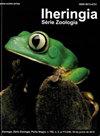Phenotypic matching in ovipositor size in the parasitoid Galeopsomyia sp. (Hymenoptera, Eulophidae) attacking different gall inducers
IF 0.5
4区 生物学
Q4 ZOOLOGY
引用次数: 4
Abstract
ABSTRACT Parasitoid ovipositor size importantly affects host choice; those attacking exposed hosts usually have shorter ovipositors compared to those needing drilling deeper through substrates such as plant tissue and gall tissue. Most studies treat this theme at the interspecific level, and the aim of this work was to test for intraspecific variation and phenotypic matching in ovipositor size for Galeopsomyia sp. attacking galls. Galls were sampled from Guapira opposita(Nyctaginaceae), a host plant to five species of Bruggmannia gallers (Diptera, Cecidomyiidae) in southern Brazil: Bruggmannia elongata, B. robusta, B. acaudata, and two undescribed species of Bruggmannia (sp. 1 and sp. 2). On forest transects, all galls from the 30 first galled plants found were sampled and kept in sealed plastic bags until parasitoid emergence. A total of 15 samples were done along two years. We measured galler last instar larvae length and gall thickness for each galling species, and ovipositor length for all Galeopsomyia sp. individuals emerging from the galls. There were no differences in larval length among galler species. However, Bruggmannia sp. 1 and sp. 2 galls were significantly thicker than those of B. acaudata, and the latter thicker than both B. elongata and B. robusta galls. Wasp ovipositor size differed significantly between those coming from Bruggmannia sp. 1 and sp. 2 galls relative to all others. Host extended phenotype size is thus fundamental to determine parasitoid size, but in this case host (larval) size does not change among species, although gall thickness was different. Thicker galls were attacked by larger parasitoids with longer ovipositors, denoting phenotypic matching. Thicker galls appear to be selecting larger parasitoid individuals, which in the long run can lead to important evolutionary change as well.攻击不同瘿诱导剂的寄生蜂Galeopsomyia sp.(膜翅目,蜂科)产卵器大小的表型匹配
寄生物产卵器大小对寄主选择有重要影响;与那些需要在植物组织和胆组织等基质中钻得更深的寄主相比,那些攻击暴露的寄主的产卵器通常更短。大多数研究在种间水平上处理这一主题,本工作的目的是测试Galeopsomyia sp.攻击瘿虫的产卵器大小的种内变异和表型匹配。采集了巴西南部五种Bruggmannia gallers(双翅目,cecidomiae科)的寄主植物瓜皮拉(Guapira opposita) (Nyctaginaceae)的虫瘿,这五种是:Bruggmannia elongata、B. robusta、B. acaudata和两种未描述的Bruggmannia (sp. 1和sp. 2)。在森林样带上,采集了30种首次被虫瘿的所有虫瘿,并将其保存在密封的塑料袋中,直到寄生蜂出现。总共15个样本在两年内完成。我们测量了每一种瘿虫的末龄幼虫长度和瘿虫厚度,以及所有从瘿虫中出来的瘿虫的产卵器长度。不同胆虫种类的幼虫长度没有差异。然而,布鲁格曼1号和2号的瘿明显厚于长尾布,长尾布的瘿明显厚于长尾布和粗尾布。来自Bruggmannia sp. 1和sp. 2瘿的黄蜂的产卵器大小相对于其他所有瘿有显著差异。因此,寄主扩展表型大小是决定寄生蜂大小的基础,但在这种情况下,寄主(幼虫)的大小在物种之间没有变化,尽管胆厚不同。较厚的瘿受到较大的寄生蜂和较长的产卵器的攻击,表明表型匹配。较厚的胆似乎会选择较大的寄生个体,从长远来看,这也会导致重要的进化变化。
本文章由计算机程序翻译,如有差异,请以英文原文为准。
求助全文
约1分钟内获得全文
求助全文
来源期刊

Iheringia Serie Zoologia
生物-动物学
CiteScore
1.00
自引率
0.00%
发文量
12
审稿时长
6-12 weeks
期刊介绍:
The journal Iheringia, Série Zoologia, edited by the “Museu de Ciências Naturais” of the “Fundação Zoobotânica do Rio Grande do Sul”, publishes original research findings in zoology with emphasis on taxonomy, systematics, morphology, natural history, and community or population ecology of species from current Neotropical fauna. Scientific notes will not be accepted for publication. Species lists without a taxonomic approach, or that are not the result of studies on the ecology or natural history of communities will not normally be accepted. The same applies to identification keys of groups of taxa defined by political boundaries. Authors wishing to inquire about the scope of the journal or the suitability of a particular topic are encouraged to contact the Editorial Board prior to submission. Furthermore, articles with a main focus on agronomy, veterinary, zootechny or other areas involving applied zoology will not be accepted.
Its abbreviated title is Iheringia, Sér. Zool., which should be used in bibliographies, footnotes and bibliographical references and strips.
 求助内容:
求助内容: 应助结果提醒方式:
应助结果提醒方式:


